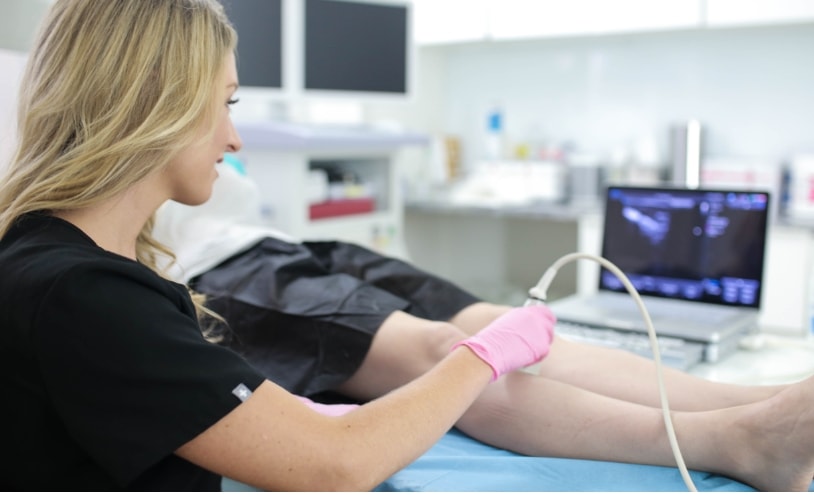Feeling a little tired or achy after a long day of standing or walking is normal. But if you find yourself constantly experiencing heavy legs, it could be a sign of an underlying condition that requires medical attention. In this article, we’ll explore the possible causes of leg pain and heaviness, when you should be concerned, and what you can do to alleviate your symptoms.

Possible Causes of Leg Pain and Heaviness
Chronic Venous Insufficiency (CVI)
CVI is a condition in which the veins in the legs fail to effectively circulate blood back to the heart. The veins have one-way valves that prevent blood from flowing backwards. When these valves malfunction, blood can pool in the legs, causing discomfort, swelling, and varicose veins. This condition is more common in older adults and people with a family history of CVI. Other risk factors include obesity, pregnancy, prolonged sitting or standing, and a history of blood clots.
Restless Legs Syndrome (RLS)
RLS is a neurological disorder that affects the legs and causes an uncomfortable sensation, which is often described as a creeping, crawling, or tingling feeling. This sensation can be relieved temporarily by moving the legs, but it can worsen during periods of inactivity or at night. RLS can affect the quality of sleep and daily activities, and it is more common in older adults and women. RLS is caused by a dysfunction in the part of the brain that controls movements, and chronic venous insufficiency is a risk factor.
Arthritis
Arthritis is a joint disorder that can affect any joint in the body, including the knees and hips. It can cause pain, stiffness, and swelling in the affected joints, which can lead to difficulty moving and a feeling of heaviness in the legs. Arthritis is more common in older adults, but it can also affect younger people. There are different types of arthritis, including osteoarthritis, rheumatoid arthritis, and psoriatic arthritis. Treatment options vary depending on the type and severity of arthritis, but they can include medication, physical therapy, and surgery.
Muscle Strain
Overuse or injury of the muscles in the legs can cause pain, soreness, and a feeling of heaviness. This can occur from repetitive activities such as running or standing for long periods of time, or from sudden movements such as jumping or lifting heavy objects. Symptoms of muscle strain can include pain, swelling, and limited mobility. Treatment options can include rest, ice, compression, elevation, pain medication, and other treatments.
Deep Vein Thrombosis (DVT)
Deep vein thrombosis is a serious condition in which a blood clot forms in a deep vein, usually in the leg. This can be caused by a variety of factors, including prolonged sitting or bed rest, surgery, pregnancy, or certain medical conditions, such as chronic venous insufficiency. Symptoms of DVT can include pain, swelling, redness, and warmth in the affected leg. If left untreated, DVT can lead to pulmonary embolism, which can be life-threatening.
When Should You Be Concerned?
If you are experiencing persistent leg pain and heaviness, it’s important to seek medical attention. You should also see a vein doctor if you experience the following symptoms:
- Leg heaviness
- Restless leg syndrome
- Frequent leg cramps
- Throbbing leg veins
- Leg pain
- Worsening pain at night
- Worsening pain after long periods of inactivity
- Skin discoloration
- Ulcerations on the legs
These symptoms could indicate a serious medical condition, such as chronic venous insufficiency or deep vein thrombosis. In these cases, you must seek vein treatments promptly to prevent the symptoms from worsening.
What Can You Do to Alleviate Your Symptoms?
If your leg pain and heaviness is caused by CVI, RLS, or muscle strain, there are several things you can do to alleviate your symptoms:
- Wear Compression Stockings: Compression stockings can improve blood circulation in the legs and reduce swelling and discomfort. They come in different compression levels and styles, so talk to your doctor about which type is best for you.
- Exercise Regularly: Regular exercise can help improve blood circulation and strengthen the muscles in your legs, reducing your risk of developing CVI and RLS.
- Lose Weight: Excess weight can put extra strain on your legs and exacerbate your symptoms. Losing weight can help alleviate your symptoms and improve your overall health.
- Elevate Your Legs: Elevating your legs above heart level can help reduce swelling and improve blood flow. You can prop your legs on a few pillows while sitting or sleeping.
- Consider Minimally Invasive Vein Treatment: If your leg pain and heaviness is caused by CVI or varicose veins, minimally invasive vein treatments, such as sclerotherapy, endovenous laser ablation, radiofrequency ablation, VenaSeal, and ambulatory phlebectomy, can alleviate your symptoms and improve the appearance of your legs.
Consult Long Island Vein Treatment
Leg pain and heaviness can be caused by a variety of conditions, ranging from mild to serious. If you are experiencing persistent leg pain and heaviness, it’s important to seek medical attention. At Long Island Vein Treatment, we offer free insurance verification even before the first appointment, and our medical centers for vein treatment are led by board-certified vein doctors who are experts in diagnosing and treating vein conditions.
If you are diagnosed with CVI or varicose veins, we offer minimally invasive vein treatments that can alleviate your symptoms and improve the appearance of your legs. In addition, there are several things you can do to alleviate your symptoms, such as wearing compression stockings, exercising regularly, losing weight, elevating your legs, and seeking medical attention.
Don’t let leg pain and heaviness interfere with your daily life. Contact Long Island Vein Treatment today to schedule a consultation and learn more about how we can help you feel better and look better. Our locations include South Shore, North Shore, The Hamptons, and Port Jefferson Area, so you can find a center for vein treatment convenient for you.